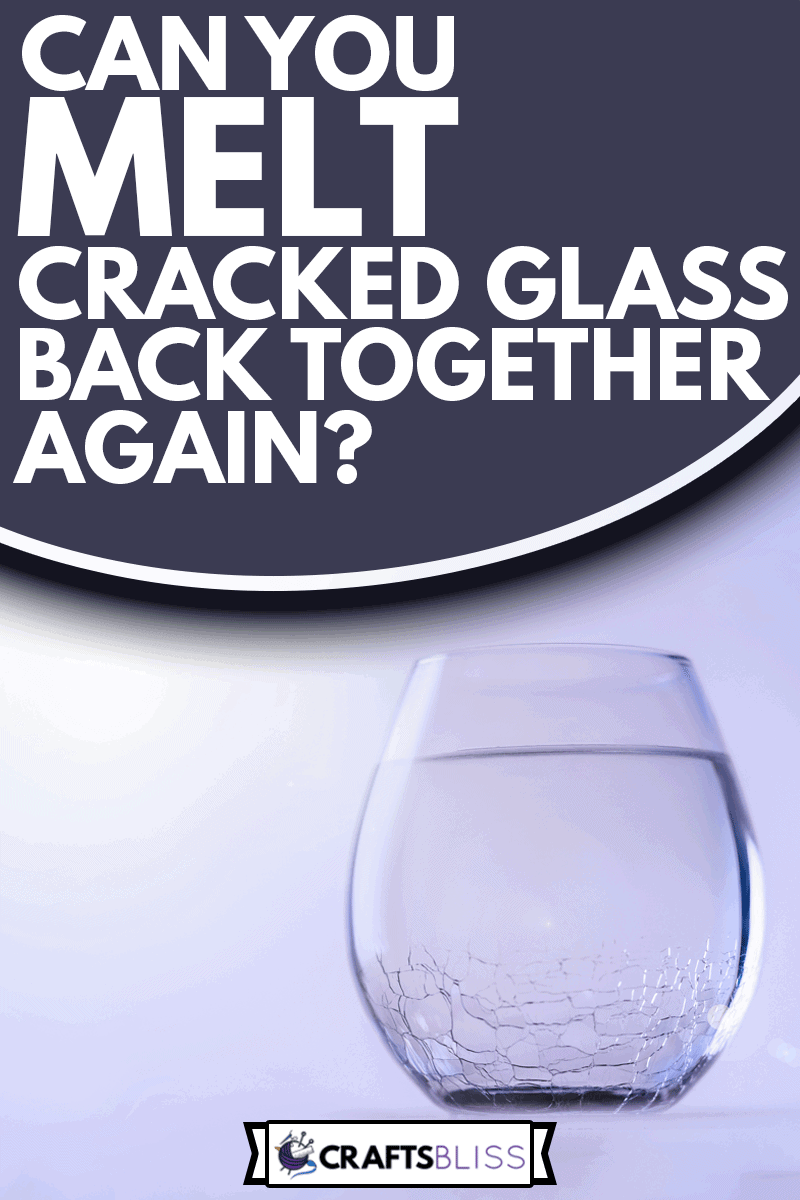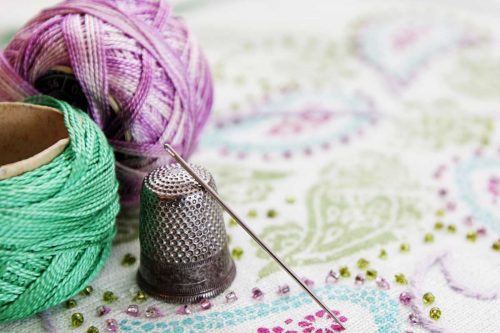Perhaps a beautiful glass chalice your mother gifted you was dropped and has begun to crack. Maybe your beloved pet knocked over your favorite vase, and now you're wondering if it is salvageable. Is your cracked glassware fixable with some heat? We've researched the answer and compiled the following information to satisfy your curiosity.
Yes, you can melt cracked glass back together. Extreme heat alters the viscosity of glass, making it malleable. Though it is possible to melt cracked glass back together, for best results consult a professional. When attempting a glass repair as a DIY project, follow some specific steps and precautions, and ensure you have all the appropriate gear to complete your project.
- Heat your oven to the highest possible temperature with the cracked glass inside.
- Gear up with the appropriate personal protective equipment.
- Ensure the blowtorch you have chosen is ready to go after removing the preheated glass.
- Insert glass pieces directly into the blowtorch's flame.
- Hold the pieces of glass together until they are fused.
- Allow the repaired glass to cool completely in the oven.
These steps might seem simple, but glass repair has many caveats. When dealing with potentially sharp pieces and high-temperature torches, safety is of the utmost importance. Please continue reading to get all the details on melting cracked glass back together.

How To Fix A Crack In Glass?
Heat Your Oven to the Highest Possible Temperature
Heating glass by immediately holding it over a torch can make certain types of glass shatter. Shatters could potentially be very dangerous. Most household glasses and vases are made of thick glass to prevent cracks and breaks, which makes it all the more important to heat the glass slowly.
Make sure the glass is very clean. Place the glass in need of repair (whether in pieces or still in one piece) into your oven while it preheats. Set your oven to the highest allowable temperature, preferably above 500 degrees is capable. Once the oven finishes preheating, allow the glass to remain in the oven for at least ten more minutes before removing it.
Gear Up with the Appropriate Personal Protective Equipment
This is perhaps the most crucial step to ensuring a smooth repair experience. Since you are likely to be staring at a blowtorch light for several minutes, it is vital to choose goggles that protect your eyes from bright light, as well as from heat or potential glass shards. Additionally, your hands will be close to a scorching flame, so fireproof gloves are a must. If at all possible, wear fire-resistant clothing, and attempt to keep your arms covered. Do not proceed to the next steps until you are safely dressed and ready!
Prepare The Blowtorch
Use a blowtorch to increase the temperature of the preheated glass, to make it more malleable. The best type of blowtorch for a beginner is a torch with a simple on/off switch. Some torches are not self-igniting, so in this case, the best option is a torch that turns on with the press of a button.
Many different gasses fuel blowtorches. For this purpose, you want to use a torch with an extremely hot flame. If you've ever wondered, "Can you melt glass with a propane torch?" you'll be happy to learn that the most highly recommended kind is a propane blowtorch. Propane torches are affordable and commercially accessible.
View this propane torch on Amazon.
Insert Glass Pieces Into The Flame & Hold Until Fused
Once you have removed your glass from the oven and placed it upon a heat-safe surface, it's time to use the torch. If the glass is in pieces, use pliers (preferably rubber handled for safety) to hold the separate pieces in the flame of the torch until they are fused. If repairing a cracked area, direct the flame toward the crack. For both methods, wait for the glass to glow red and fuse. Gently use metal tools (think a metal file or flathead screwdriver) to smooth the cracks.
Allow the Repaired Glass to Cool Completely in the Oven
After the glass fuses, place the piece back into the oven at the maximum temperature. Allow the glass to bake an additional 10 to 15 minutes with the oven already heated. After that time has elapsed, turn the oven off, but do not remove the glass until the oven has cooled. Removing the glass too soon could compromise the integrity of the glass, making it easier to shatter. In a perfect world, the glass should rest in a kiln heated to a thousand degrees. Because most homes don't typically have this type of equipment, it is best to use the oven.
To see these steps in action, please watch this video of how to repair a chipped glass.
Does Superglue Work on Cracked Glass?
There are certain types of super glue that work on cracked glass. Any home improvement store will carry superglue explicitly made with glass in mind. Be sure always to follow the manufacturer's instructions. Be aware that using regular superglue won't get the smoother finish of a glue made for glass, and the results might not be as pretty. Using glue to repair cracks will not be as seamless as other available methods.
For a quick fix, you might wonder, "What is the best glue for glass?" Our recommendation is the tried and true Loctite glass glue. Loctite is the only patented superglue formulated explicitly for glass. Loctite proves a long-lasting, clear bond for glass repair.
View this glass glue on Amazon.
What is Liquid Glass?
Regular glass is covered in tiny, microscopic flaws. It is those flaws on the surface that cause tiny breaks, full-on breaks, and eventual shatters. Liquid Glass is a material made of silicon dioxide (essentially, glass in liquid form carried in water or ethanol) that smooths over the surface of the glass, filling in those imperfections and erasing them. Glass treated with liquid glass is much less likely to break. Although liquid glass can prevent the glass from breaking, it cannot repair cracks once they have happened.
View this liquid Glass on Amazon.
How Do You Make Cracks in Glass Disappear?
If you're not ready to try your hand at glass working, there are other methods to consider when repairing glass. The easiest and safest way is with two-part epoxy and a few simple tools. The two parts are generally a resin and a hardener.
Simply mix the two parts of the epoxy on a disposable plate or a piece of cardboard. Then, apply to the crack using a putty knife by pressing the mixture into the damaged area. Work quickly because the epoxy will harden swiftly. Allow the epoxy to cure at least five minutes before scraping away the excess with a razor blade. Leave it alone for at least 24 hours before cleaning the area with a glass cleaner or dish soap.
View this two-part epoxy on Amazon.
To Conclude
Although you can use some dangerous tools to attempt to melt cracked glass back together, always keep in mind there are professionals out there who can care for your treasured items. Consider all your options before attempting to melt the cracked glass back together. If the repair you're making isn't on an item with sentimental value, feel free to go for it. Manipulating glass can be its form of art, so let yourself get creative, and you might discover a new hobby in the process.









![Read more about the article How To Glue Glass Beads To Glass [6 Steps]](https://craftsbliss.com/wp-content/uploads/2020/10/Different-colored-glass-beads-on-a-white-background-500x333.jpg)

You should tell people that although this is the proper way to do this. This is not a good idea to do this. Because if you drop one piece of glass on your floor your floor is going to catch on fire. And gas build up it’s just not a good idea.
I don’t understand how you can use a household oven that tops out at 500-550 F and only goes up to 800-850F during the locked cleaning cycle…. Being able to melt glass together because when glass is made it’s at extreme temperature at 3,095F no oven is going to be hot enough to melt glass and also there are different types of glass even if it may look alike the compounds that go into each type are different.
Bro, this isn’t saying to put it into an oven to melt it back together; it’s only to heat the glass up PRIOR TO using the torch, that is then used to actually weld/melt the pieces together. Going full blown (pun intended) with a torch to room temp glass almost guarantees it breaking/cracking further due to thermal stresses; with a piece that is already damaged you can put the odds of it breaking further (into un-repairable pieces) to near absolute.
Glass expands when heated and contracts when cold -obviously- when a select area of glass is quickly heated there isn’t much (if any) place for it to expand into, so tremendous pressure is put on the cooler, surrounding glass, until it shatters. Typically on a slight imperfection, or any existing chip, or crack.
Heating the whole piece, slowly and evenly helps in reducing those forces by pre-expanding the glass -so to speak.
Hi, I have a thick mog type glass. It has a vertical crack in it, but it’s not broken apart. After I heat the glass as directed, do I just concentrate the torch on the cracked area and does make the crack disappear?
Regards,
Gary